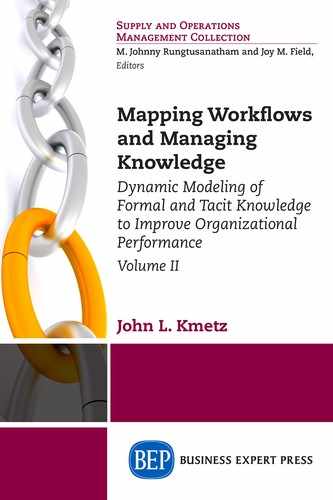I have several objectives in mind for this short book, but unlike Volume I, none of these can be applied immediately. The reason for this will become clear when I explain what those objectives are.
First, I want to provide an overview of system dynamic (SD) modeling. By an overview, I mean just that and no more—I do not intend to explain how to do dynamic modeling in great depth, since there are both other resources available to do that, and it would take a much larger volume than this one to do so. Second, I want to stimulate interest in SD modeling, sufficient to motivate some of my readers to learn it and do it. Part of this is my third objective, which is to illustrate the benefits of dynamic modeling from my own experience with it and from some other sources as well. Finally, I want to provide a plan forward for those who intend to pursue SD modeling. For many readers, this will be a transition from the static models generated by using my method of workflow mapping; for others, it may be a transition from a more structured, and perhaps more rigid, method of mapping or modeling workflows.
This volume is specifically organized around the application of iThink software, to the exclusion of many other forms of modeling software. The reasons for this are also several: first, iThink has many features in common with my workflow mapping symbols, so that transition is easier from a Kmetz workflow map than might be the case with others. Second, the software does not require strong mathematical or programming skills, but places a premium on clear thinking; the math required is written in the background by the software, and can be manipulated by those with the skills to do it, but competent and effective models can be created by anyone. Third, there is a large and growing user community for iThink, which means that not only are many others out there on the Web who can be called on for help and ideas, but that there are many commonly used models already available, and these may fit many needs or can easily be modified to fit specific circumstances. Nonsave versions of iThink are also available, so prospective new users can try it and need not invest in the software until they are sure they want to use it.
It is not the objective of this volume to train readers in sufficient depth that they can do modeling. Rather, I want to provide enough information to readers to allow them to decide whether they want to go further, and for those who do, provide a list of external resources to do more. The void this book fills, in my view, is the need for a briefing on the potential for SD modeling and a look into what is involved in doing that with iThink, in the shortest possible time. If the reader wants to go beyond that, there are several ways to go, from hiring a consultant to work with you to learning the software and doing it yourself. Most users go for an intermediate level of involvement by allowing an external modeling expert to have a bit of their time to demonstrate the operation of the software, and then to help the user ask the right questions in building the model.
The real value of models is not how well they predict the future or explain events, but how much we can learn from them. In one short sentence, that learning is the objective of this book.
